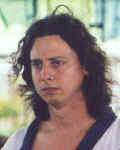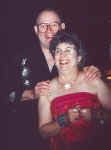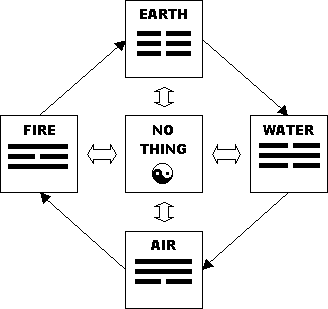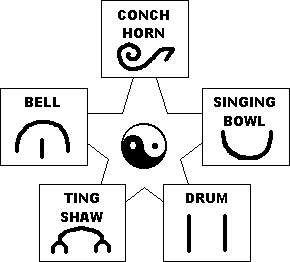| THE CAST OF CHARACTERS | |
No play is complete without a cast of characters. In our case, most of the people watching this play are actually in the play. |
|
| THE GROOM’S PARENTS – Arnold & Dara Steinkamp They don’t think of it as loosing a son, they think of it as gaining a daughter. |
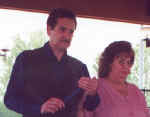 |
| THE BRIDE’S PARENTS – Jack & Virginia Kent Their fondest wish is that the couple are happy and that they grow and prosper together – and if the kids want video games and a bar-b-q, then so be it. |
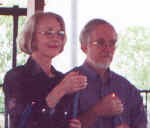 |
| THE GROOM – Shane Steinkamp |
 |
|
THE BRIDE’S MAID – Kathy Pfister |
 |
| THE MAN AT ARMS – Frank Sewell Frank watches – and we suspect hopes for – trouble on the wedding day. His sworn duty is to solve problems. |
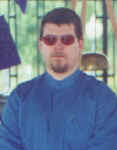 |
|
THE OFFICIANT – Edward L. Goldman III |
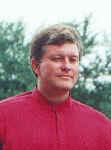 |
|
SEVEN
WATER BOWLS A common custom in Tibet is to place seven bowls of clean water on the family altar each morning. This is done, along with the lighting of a lamp or candle, as a reminder of the eight hospitalities that should be offered to guests at one’s home: water for drinking, water for washing one's feet, flowers, incense, illumination, scented unguent (perfume), fruit, and music. Played
by: Eileen
‘Mom’ McWhorter Billy
‘The Plumber’ Carter Paulette
‘Boo’ Garretson Phil
‘The BBQ King, aka Fry Daddy’ Pfister Shawn
‘The Brother’ Steinkamp Eddie
‘The Other Brother’ Kent Wendy
‘The Best Man’s Favorite Person, and we really like her too.’ Tuger THE FIVE ELEMENTS The five traditional
‘elements’ are an important part of oriental medicine, philosophy, and
spirituality. All things can be
thought of as combinations of these base ‘elements’. Earth – Josefa Wilson ‘Mother Earth’ is a
much heard colloquial expression. This
idea of earth as mother is common across all ideologies. Earth, as an element, is literally all of the substances that
comprise the planets and the stars. Earth
is stable power, nurturing, and passive energy. Its spirit is represented by a
mother. Earth is carried in a
Lotus Singing Bowl filled with soil and Earth’s treasures.
Included are rocks we have collected and given to one another over the
years, and other rocks given to us by those who know our love of such things.
There’s treasure everywhere. No Thing – Alexandra Wilson No Thing should not be
confused with ‘nothing’. Sometimes
rendered as ‘The Void’. An
innocent girl represents its spirit. “What is called the
spirit of the void is where there is no thing.
It is not included in man’s knowledge. … By knowing things that exist, you can know that which does
not exist. That is the void.
Following (in the way of) the void is virtue, and no evil.
Wisdom has existence, principle has existence, the way has existence,
spirit is no thingness.”[1] No Thing is carried as a
clear glass sphere that once belonged to our friend Deanna.
It is solid glass with no apparent space inside.
Since no thing represents the void, that which is not included in man’s
knowledge, it seems appropriate to us that its symbol comes from someone who has
left our world and gone on ahead of us. Air – Steve McWhorter Air
is the air we breathe, an essential element of life – like a good friend.
Air is swift, changeable, and
projective; the power of breath and life. Wind,
or Air, is carried within a large, hollow glass sphere.
The gold design on the outer glass emphasizes the sphere’s hollowness
and calls our attention to that which exists within – air. Water – Stuart Williams Water is tidal power,
positive and dynamic ancient power. Water
is carried in an old frosted glass bottle.
The glass resembles what sea glass looks like when it has been tumbled by
the waves. The bottle holds sea
water from Navarre Beach, whish is a special place to us.
Floating in the water is some of the treasure we have found on our
adventures there. Shells, stones, and sea glass – as was said earlier,
treasure can be found everywhere. Fire – Arnold & Dara Steinkamp and Jack & Virginia Kent “Illumination doubled
makes fire. Thus do great people
shine on the four quarters with continued light” – The I Ching. The fire
of the spirit is said to be passed as original jeng to an embryo at
fertilization. A wedding is a kind
of birth from which a new being is formed.
Parents signify their consent to a marriage by passing the spirit of
family to the new couple. This
spirit is symbolized by fire in the ceremony of candles.
THE FIVE SACRED SOUNDS[2] It
is interesting to note that these objects are less important than their sounds.
A jewel encrusted and richly engraved instrument may be very beautiful,
but if it has a poor sound, it is considered to be of very little value.
The Sacred Sounds, then, are not to be thought of in terms of the
instrument that produces them. There
is no worship associated with these objects, although they are greatly respected
and prized for the sounds they make. Conch
horns have been known almost universally since ancient times.
Buddhist legend relates that when the Buddha attained enlightenment, he
gave no teaching for forty-nine days. He
was very sad, because he was the only one who was enlightened, and not knowing
what to do, he decided to hide in the forest.
Indra, the King of the Gods, asked him not to hide, but rather to give a
teaching. Agni gave him a conch horn, and when Shakyamuni (The Buddha)
played it, the first teaching of Dharmachakra (The Wheel of the Law), which is
known as the Four Noble Truths, was revealed.
It is said that at this time the wheel of the law was put into motion,
and it was possible thenceforth for human beings to attain enlightenment and
salvation. (This is amazingly
similar to the concept of Jesus’ salvation for all of mankind.) The
Four Noble Truths are 1: All existence entails suffering (the Truth of
Suffering). 2: Suffering is caused by ignorance, which gives rise to suffering,
which gives rise to craving and illusion (the Truth of Cause). 3: There is an
end to suffering, and this state of no suffering is called Nirvana (the Truth of
Extinction). 4: Nirvana is attained through the practice of the Eight-fold Noble
Path (the Truth of the Path)[3].
Even today, the sound of the conch is called Dharmachakra.
So, in the tradition of Buddhism, from the first teaching of the first
Buddha, there is a tradition of using sound in connection with teaching.
It is said that those who hear this sound (and receive the teaching) will
never go to Narak[4],
a low plain in the underworld. This
conch horn is a genuine Tibetan artifact. It
has been dressed with silver and turquoise, and hand carved with a guardian
deity. Paul and I have stumbled
through the Four Noble Truths together all our lives. Bell
– Kathy Pfister The ritual scepter called vajra and bell (ghanta, dril bu, or dorje) are important ritual elements in Buddhism. The vajra symbolizes the active male (yang) aspect of enlightenment usually associated with skillful means, compassion, or bliss. The vajra evolved from the thunderbolt-scepter wielded by the Vedic god Indra (also called Shakra). When used in ritual, the vajra is paired with the bell which represents the feminine (yin) principle of wisdom. These twin principles of compassion and wisdom are indispensable to the attainment of enlightenment. This bell and vajra are modern copies of ancient relics. They have been silver plated. Kathy is pregnant with a son, and therefore literally embodies the idyllic dualism of male power and female wisdom. Singing
Bowl – Bob Lindsey Padmasambhava,
a seventh century Indian tantric master who traveled to Tibet spreading the
Buddha's teachings and displaying miraculous powers, said, “When the iron bird
flies, the Dharma (Teachings of Truth) will be spread to the West.”
Tibetan singing bowls have indeed traveled across the Himalayas, along
ancient trade routes, and have been brought to the west by the iron bird.
Singing bowls are very special to me, because they speak to me in a special way
– a way I cannot express in words. Bob
is that way too. It seems to me
that one does not ‘play’ a singing bowl, rather one makes a kind of love to
it. The
history of these bowls is very difficult to trace, especially since the loss of
so much religious history during the Chinese occupation of Tibet. I suspect that
bronze bowls emerged for common use during the Asian Bronze Age, and it was
discovered somehow that the bowls could be made to ‘sing’.
Singing bowls, as such, have been known since the time of the historical
Buddha (560 - 480 B.C.). Through
the years, craftsmen improved on the alloy and design to improve the ‘voice’
of the bowls. Eventually there were
several small factories in Tibet that carefully crafted singing bowls using a
special process that is now lost. The
bowls are said to be made from seven elements, but a metallurgical analysis,
done by the British Museum in London, reveals that the finest instruments are
made of a twelve metal alloy consisting of silver, nickel, copper, zinc,
antimony, tin, lead, cobalt, bismuth, arsenic, cadmium and iron.
This iron is supposed to be meteoritic iron, and gold was used in many
bowls. The
term ‘Tibetan Singing Bowl’ is actually a misnomer, since the original
singing bowl came to Tibet from India – possibly originating in Nepal or
Indonesia. The first singing bowl
was brought to Tibet by the second incarnation of Buddha whose name was Sange
Wasong. It is now a holy relic housed behind Drepung Monastery, located in
Lahsa, which housed the palace of the Fifth Dalai Lama. Wasong used this bowl as
a begging bowl, which was evidently common practice.
On July fifteenth of every year, many Tibetans visit this singing bowl to
hear it sing. They bring offerings of money and other things to the
monastery to be allowed to play this bowl themselves.
It is said that if someone has pure karma, the bowl will make a big
sound, and if the person has impure karma the bowl won’t make any sound, or
will make a bad sound. During the
ceremonies, monks from the monastery and other monks who have come on a
pilgrimage, bring their singing bowls and play them. Over four thousand monks play their singing bowls during a
ceremony at the monastery. There
are only three of these ‘relic’ bowls in Tibet.
All others are considered copies. The
sound of the singing bowls is said to contain many teachings, about broadness,
emptiness, the Four Noble Truths, and many others, but the bowl’s most special
teaching is the one of No Thingness, or the Void. Actually, the bowl’s particular sound ‘wang, wang, wang,
wang, wang’, means emptiness, empty, empty, empty, empty... This is the
essential teaching of Buddha, which is that all things are as they are –
empty. It is said that even though
one has the mind of the Buddha, but does not receive this teaching of emptiness,
enlightenment cannot be attained. It
is also said that the bowl is a means of travel to Shambhala, a mystical kingdom
said to exist hidden from the world where a line of enlightened kings is said to
be guarding the highest wisdom for a time when all spiritual values in the world
outside will be lost. There is a meditation that goes along with the sound.
This meditation is, “Where does the sound go?”
This
bowl, an authentic antique from Tibet, is over 300 years old.
It is hand hammered from the traditional metals. This bowl was hand
turned and polished, as is evidenced by the grooves visible on the inside of the
bowl. Ting
Shaw – Maggie Lindsey The
Ting Shaw is a type of Tibetan bell, usually found in matched pairs with a
leather thong or metal chain linking them. Looking like small saucers, they are
made of an alloy of many metals, and produce a brilliantly clear resonant tone
when struck together on their edges. When played, usually during the Tibetan
ceremony for the dead, they are said to satisfy, or bring relief to, the
‘hungry ghosts’. You can think
of these as actual ghosts, or as a metaphor for cravings of desire.
Maggie has fed us – thus satisfying our cravings of desire – more
time than we can count. This
Ting Shaw are of modern manufacture, and bear the glyphs for “Om
Mane Padme Hum”, which is a Tibetan Mantra that means, “The Jewel is in
the Lotus.” Drum
– Frank Sewell The drum has been called the oldest musical
instrument. The sound of the drum
– the heart beat – is the first sound we all hear as soon as our ears start
working in the womb. Since
man's early beginnings, there are stories of ceremonies that include rhythm and
dancing. Perhaps it began by early man listening to the natural rhythmic
sounds, like dripping water, and attempting to keep time with them by clapping
their hands, slapping stones or bones, banging on hollow logs, or striking two
sticks together.. Once man discovered
that hollow logs made deep sounds that carried, he learned how to make different
acoustics. Following this, man further advanced this musical art by
learning how to stretch skins across the open ends of hollow logs. The sizes and
shapes of these mystical sounding noise makers varied from different cultures,
and drum-worshiping societies. They were used for many types of
ceremonies, from warding off evil spirits, for war cadences, for celebrations
that marked important events. As time and cultures progressed, so did the
drum. This drum is of modern Tibetan manufacture. The sound of the drum, a traditional battle sound, is fittingly sounded by the Man at Arms.
[1] The Book of Five Rings, Myamoto Musashi, The Book of the Void [2] Some of this information
was taken from an interview by Randall E. Gray, which bears his copyright ©
1989. (www.bodhisattva.com) [3] Right View (which means
knowing the Four Noble Truths), Right Thinking or Right Aim, Right Speech,
Right Action, Right Living, Right Effort, Right Mindfulness, and Right
Concentration. [4] Narak is usually translated as ‘hell’, but really has a different connotation. In the Buddhist tradition, there is no real hell – only levels of existance. Narak is one of the lowest of these levels. |

